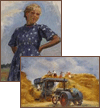 |
 |
 |
|
|
||||
|
The works on exhibition go back to the 30s-60s of the 20th century and correspond to the notion of "socialist realism". For many decades the tendency which dominated exhibitions, art schools and institutions and became irrelevant with the change of ideology was almost forgotten. Artists' Societies were headed by representatives of another generation with other creative beliefs. Artists were gone and their works which aroused little interest at state museums attracted foreign collectors' attention. Lots of paintings and sketches often in very bad condition were bought cheap and taken to the West. At the time when there were many paintings they were not appreciated. But at present there has occurred a sweeping change: "The New Hermitage - 1" art gallery gives us a wonderful opportunity to look back, feel and evaluate, analyze and understand the time, the artists, the paintings. It should be said that the notion of the "socialist realism" itself is rather conventional. As any other trend it exists within the overall context of cultural evolution: it could not appear by accident or by somebody' will. Many artists of the older generation who experimented with colour and shape and joined various creative societies in the 10s-20s turned to realism in the 1930s, and it would be too primitive to explain this phenomenon by mere political conditions in the country. Talented apprentices of these artists - and it should be said that there were many of them, - absorbed their teachers' culture, developed the ideas of the realist art based sometimes on the traditions of the 19th-century Russian realist school and changed in accordance with the rhythms of modern life. All paintings on exhibition have something in common - something that has to do with the style of painting, something that cannot be defined by the crude term "socialist realism". Tremble… the tremble of life, light, paint, the tremble of the artist's brush, the tremble of his soul, because a painting springs up only then when the author cannot but makes it the way it is… It is this tremble that attracts us. The secrecy of each work turns to a certain melody with its own theme, deviations and nuances but on the other hand a very integral one. Its magic sounds unite B.A. Shatilov's "By the Bolshoy Theatre" and "In the Tram" and S.M. Kamanin's "Tugboat Construction" and "Bukhtarma Hydro- Electric Power-Station"; the melody changes the key in the burning colour of T.N. Hippius's Central Asian works, gains a firm hold in P.A. Krivonogov's "The Fighters' Rest" and A.A. Korobov's "Musicians", it is major in the bright G. G. Ryazhsky and V.B. Koretsky's landscapes, lyrical in I.P. Witman, E.N. Tarakanova and F.M. Kaplan's works. A key of their own have N.B. Terpsikhorov's works and surprisingly harmonious Moscow landscapes. This melody reflects the beauty of the everyday life, human feelings and affections; it was not made on ideological or social commission - it flew from the very being of painters and their models. On exhibition there are no representatives of the so-called "semi-official" art, i.e. innumerous portraits of the leader and other paintings of the kind. Although they are considered characteristic of the style they overshadow the very flow of life. The canvases on exhibition can be easily arranged according to their chronology and subjects: one is born (T.N. Hippius's "In the Maternity House"), a couple of days later - "Out of the Maternity House", one gets older, skis, takes part in the round dance ("Holiday at School"), goes "To the Pioneer Camp" and gets nervous "Before the Exam", works, serves in the army, has rest, gets married, has children, grandchildren and at last - T.N. Hippius's "Together with the Grandmother in Front of the TV-Set". Very soon there will be another life: family life will become easier, but will there be so many smiles as we can see here? The exhibition cannot but affect everybody. Everyone finds a painting that brings back some personal memories: the glider the children glue on the verandah, the girl with ice skates - you also liked to skate; the bench in the park - the park reminds you of the one your grandmother used to walk with you in, and here are you - wearing a white fur-coat and a child's cap. Let us sincerely thank the artists who had imprinted the time they lived in, who had worked honestly and professionally despite the difficult conditions. Let us thank all those who have managed to preserve their works, the organizers who have found the paintings and now exhibit them. And… let's remember! Maria Komarova, expert of "The New Hermitage - 1" gallery, member of the Moscow Artists' Society. P.S. The exhibition is on till December 26, 2002, open: Monday - Friday: 12.00-17.00, closed: Saturday - Sunday. |
|
||||||||||||||||||||||||||||





















